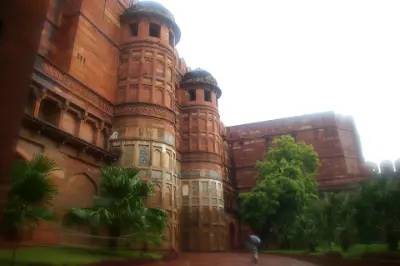Taj Mahal

Welcome to the Taj Mahal
The Taj Mahal : A Masterpiece of Mughal Love and Architecture.
The Taj Mahal, an architectural gem located in Agra, Uttar Pradesh, India, is much more than just a mausoleum. Built between 1632 and 1653 by Mughal Emperor Shah Jahan, this monument stands as an eternal testament to his deep love for his beloved wife, Mumtaz Mahal, who died in childbirth in 1631 during the birth of their fourteenth child.
This architectural masterpiece, recognized as a UNESCO World Heritage Site in 1983, is a sublime example of Mughal architecture, harmoniously blending Persian, Islamic, and Indian influences. Built of translucent white Carrara marble, the Taj Mahal spreads over an area of 17 hectares, including perfectly symmetrical gardens, ponds, and ancillary buildings.
A conservation challenge :
Unfortunately, air pollution, mainly caused by local industries and road traffic, is gradually threatening the pristine whiteness of this monument. Carbon particles and industrial emissions have caused the marble to gradually yellow, requiring regular conservation interventions.
The Archaeological Survey of India (ASI) has implemented a rigorous cleaning program. The marble structure is meticulously cleaned every two to three years, using specialized techniques such as Multani clay (Fuller's earth), which restores the original whiteness without damaging the marble.
A Monumental Entrance :
The main entrance to the Taj Mahal is through the "Great Gate" or "Darwaza-i-Rauza," an impressive structure made of red sandstone and white marble that is in itself a remarkable example of Mughal architecture. This monumental gate, 30 meters high, is adorned with Quranic calligraphy and delicate geometric patterns, announcing the splendor of the mausoleum that is then revealed to visitors. A universal symbol beyond its architectural history, the Taj Mahal remains a universal symbol of love, considered one of the most romantic monuments in the world. Every year, millions of visitors from all over the world come to admire this monument, which represents not only an architectural masterpiece, but also a testimony of extraordinary emotions.
Video of the Taj Mahal in Agra
Continue to the Red Fort
The Red Fort of Agra, located in the historic city of Agra, India, is an iconic monument of Mughal architecture. Built of red sandstone, it was erected in the 16th century by Emperor Akbar as a royal residence. Today, it is a UNESCO World Heritage Site and attracts thousands of visitors each year.

